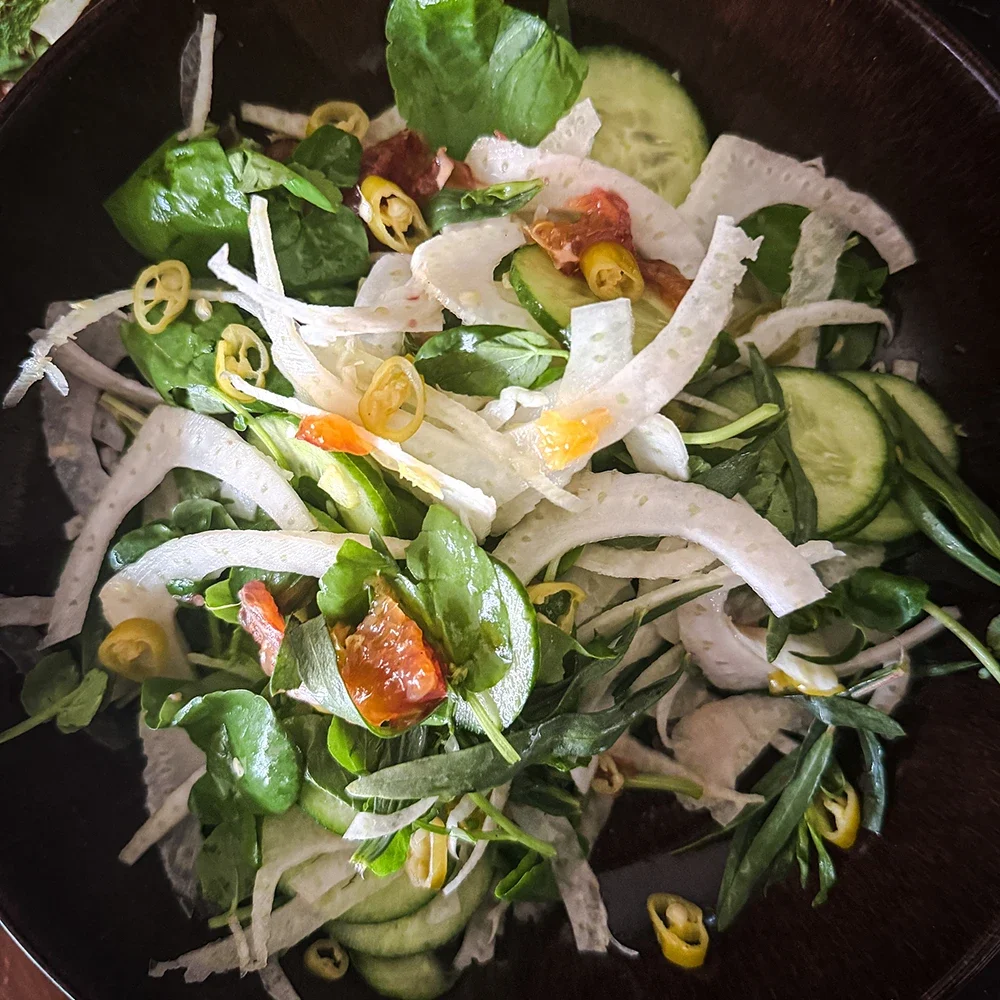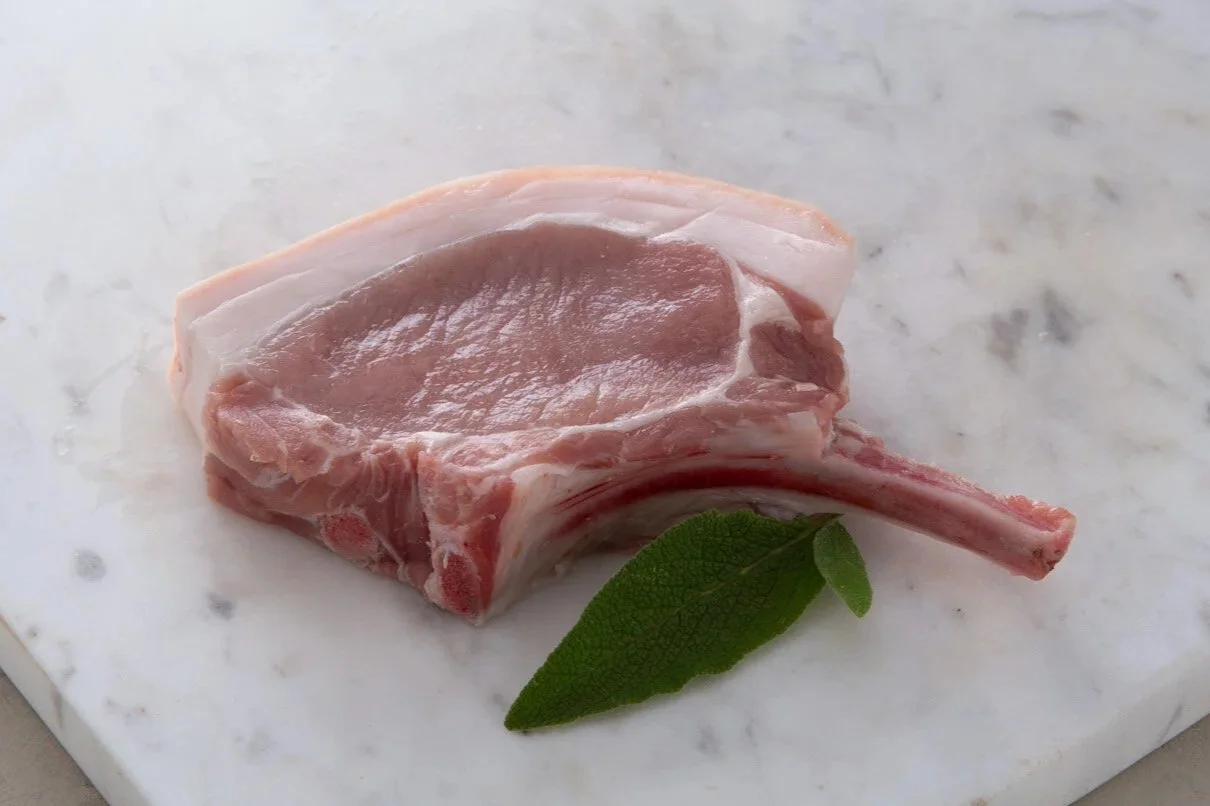Pork Cottoletta with Fennel and Blood Orange Salad
Cotoletta, crumbed cutlets or chops; What you call them may depend on how hard it is for people to pronounce your surname, or it could be that you lean a little more Bouquet than Bucket. Whatever the name, crumbed meats on the bone are a much-loved dish from family dining tables to bistro menus. The thinner schnitzel is also delicious, but there is something special about a thicker cut, perfectly crumbed and cooked cutlet.
This recipe is for a pork cutlet. Loin chops are ideal, providing tender meat and the right amount of soft fat. Ask our butchers to trim the skin, or do it yourself; it can be saved and added to broths or braises, adding richness and texture. Lamb chops are just as delicious when prepared the same way. You can use yoghurt in place of half of the milk and swap out the orange for lemon if you have it.
Crumbing is simple. Season the meat, then coat it with flour, egg, and finally bread crumbs. Keep one hand for the dry (flour and crumb) and one for the wet (egg). If you can stick to this, you won’t “crumb” your fingers. It seems some people do this instinctively, while others, like myself, need to repeat the wet/dry mantra every time to avoid being thoroughly coated.
The better the crumbs, the tastier the result. I freeze leftover bread and then periodically dry the pieces in the oven and blitz them into crumbs in a food processor or blender. Sourdough, sandwich bread, and multigrain all go in together, making for a flavorful crumb for coatings or stuffings. In the immortal words of Ina Garten, if you don’t do this, then store-bought is fine. In this case, it really is. Use what you have. If you have old bread, great, make your own. Running low on crumbs? Blitz some nuts, oats, cereal, bran flakes or even add some dry polenta. The texture will change, but everything can still work.
The simplest crumbing processes advise seasoning just the breadcrumbs, but this overlooks the opportunity to infuse deliciousness into every layer. I season the meat, flour, egg mix, and crumbing. I nearly always add mustard, hot sauce, or other condiment to the egg layer, and citrus zest, fresh herbs and parmesan to the crumb. Dry spices are best added to the flour to minimise the chance of burning.
The herbs I have used are a suggestion, and I encourage you to use what you have. If you have an abundance of fennel, use the fronds. Do you have a bunch of dill instead? Also delicious! I tend to mirror the herbs in any accompanying salads or side dishes in my crumbing; it helps use up what I have, and using a herb in both a cooked and raw form makes a dish cohesive and delicious.
Frying your cotoletta is not the time to skimp or take shortcuts. Use the best olive oil and butter you have. The olive oil coats the bottom of the pan, protecting the butter from burning, and the combination makes a delicious crust, without the greasiness of seed or vegetable oils. The cooking temperature is gentle; you don’t want to burn the crumb. If you take it slow and there aren’t any burnt bits, you can even throw some capers, anchovies, parsley, lemon juice and a little more butter in after you remove them from the pan to make a pan sauce. A fried egg is a classic addition when doing this.
The salad is great as it is. It can also be used as a topping over wedges of lettuce or mixed with warm potatoes. If you want to use up all the vegetable ingredients, I keep the watercress aside, and dress the fennel, herbs, and cucumber with good-quality wine or sherry vinegar and salt; these last a week, and over time soften into a pickle. I mix in fresh greens and dress with olive oil when serving.
INGREDIENTS (Serves 4)
4 x pork cutlets, skin removed, approximately 280-300g per piece.
Approx ⅔ cup extra virgin olive oil
100g unsalted butter (if using salted, reduce the seasoning in the crumb)
The Crumb Mix
200 g Bread crumbs
80 g grated Parmesan or Pecorino cheese
1 tbsp chopped fennel fronds
Zest of 1 orange (Keep the flesh for the salad)
Pinch of salt
The Egg Mix
4 large eggs
¾ cup milk
1 tbsp mustard (I like Dijon, use your favourite)
Pinch of salt
Finely ground pepper to taste
The Flour Mix
1 cup plain flour
½ tsp fine sea salt
½ tsp fresh ground pepper
Optional: 1 tspn smoked paprika added to the flour. This adds a smoky flavour, and I often include it when making a more wintery version with spuds and veg instead of a salad.
Fennel, Blood Orange, and Watercress salad
½ large fennel bulb, finely sliced
3 cups watercress, remove the thickest parts of the stem
3 blood oranges (or other sweet variety). Zest two, and fillet or slice the flesh of the 3rd orange that was used for the crumb
1 tbsp salted capers, washed and drained
1 small cucumber sliced
½ bunch tarragon leaves, picked from the stem
2 pickled chillies, sliced (optional)
Dressing
60 ml extra virgin olive oil
20 ml sherry or wine vinegar
1 tsp Dijon mustard
Salt and pepper to taste
METHOD
Preheat your oven to 160°C. Fill three wide bowls or trays with the flour, egg and crumbing mixtures. Lightly season the cutlets, and then coat them first in flour, then egg, and finally in the crumb. Shake off any excess. You can repeat the process to fill in any spots that look a little thin.
Prepare an oven tray with absorbent paper on the base and a wire rack.
If cooking all the cutlets at the same time, add enough olive oil to cover the bottom of the pan with a few millimetres of oil; this will be ½ - ⅔ of a cup. For batch cooking, reserve half of the oil and butter to allow a change of oil between batches. Add the butter, and heat until it foams.
Gently cook the cutlets until golden on each side, about 5 minutes per side. Remove from the pan, dab with kitchen paper, and place on the tray with the wire rack. Once you have cooked all the cutlets, finish cooking in a moderate oven. You can confirm the doneness by using a probe thermometer; around 63°C will have a light blush of pink, or you can aim for 70°C if you prefer.
For the salad, combine the sliced fennel, cucumber, picked watercress, orange zest and fillets, capers, tarragon and pickled chilli (optional) in a large mixing bowl, gently mixing and fluffing with your hands to preserve the delicate herbs. Use a jar or small bowl to whisk or shake together the olive oil, vinegar, mustard, salt, and pepper to form an emulsified dressing. Coat the salad and gently toss just before serving.
Optional to serve: Char-grilled lemon halves or fresh lemon wedges. Mustard, pickles or hot sauce. The salad is also delicious with grated Parmesan or Pecorino cheese.
Scroll down for printable version.

Pork Cottoletta with Fennel and Blood Orange Salad.
Cotoletta, crumbed cutlets or chops; Whatever you call them may depend on how hard it is for people to pronounce your surname, or it could be that you lean a little more Bouquet than Bucket. Whatever the name, crumbed meats on the bone are a much-loved dish from family dining tables to bistro menus. The thinner schnitzel is also delicious, but there is something special about a thicker cut, perfectly crumbed and cooked cutlet.
Ingredients
- 4 x pork cutlets, skin removed, approximately 280-300g per piece.
- Approx ⅔ cup extra virgin olive oil
- 100g unsalted butter (if using salted, reduce the seasoning in the crumb)
- Crumb mix
- 200 g Bread crumbs
- 80 g grated Parmesan or Pecorino cheese
- 1 tbsp chopped fennel fronds
- Zest of 1 orange (Keep the flesh for the salad)
- Pinch of salt
- Egg mix
- 4 large eggs
- ¾ cup milk
- 1 tbsp mustard (I like Dijon, use your favourite)
- Pinch of salt
- Finely ground pepper to taste
- Flour
- 1 cup plain flour
- ½ tsp fine sea salt
- ½ tsp fresh ground pepper
- Optional: 1 tsp smoked paprika added to the flour. This adds a smoky flavour, and I often include it when making a more wintery version with spuds and veg instead of a salad.
- ½ large fennel bulb, finely sliced
- 3 cups watercress, remove the thickest parts of the stem
- 3 blood oranges (or other sweet variety). Zest two, and fillet or slice the flesh of the 3rd orange that was used for the crumb
- 1 tbsp salted capers, washed and drained
- 1 small cucumber sliced
- ½ bunch tarragon leaves, picked from the stem
- 2 pickled chillies, sliced (optional)
- 60 ml extra virgin olive oil
- 20 ml sherry or wine vinegar
- 1 tsp Dijon mustard
- Salt and pepper to taste
Method
- Preheat your oven to 160°C. Fill three wide bowls or trays with the flour, egg and crumbing mixtures. Lightly season the cutlets, and then coat them first in flour, then egg, and finally in the crumb. Shake off any excess. You can repeat the process to fill in any spots that look a little thin.
- Prepare an oven tray with absorbent paper on the base and a wire rack.
- If cooking all the cutlets at the same time, add enough olive oil to cover the bottom of the pan with a few millimetres of oil; this will be ½ - ⅔ of a cup. For batch cooking, reserve half of the oil and butter to allow a change of oil between batches. Add the butter, and heat until it foams.
- Gently cook the cutlets until golden on each side, about 5 minutes per side. Remove from the pan, dab with kitchen paper, and place on the tray with the wire rack. Once you have cooked all the cutlets, finish cooking in a moderate oven. You can confirm the doneness by using a probe thermometer; around 63°C will have a light blush of pink, or you can aim for 70°C if you prefer.
- For the salad, combine the sliced fennel, cucumber, picked watercress, orange zest and fillets, capers, tarragon and pickled chilli (optional) in a large mixing bowl, gently mixing and fluffing with your hands to preserve the delicate herbs.
- Use a jar or small bowl to whisk or shake together the olive oil, vinegar, mustard, salt, and pepper to form an emulsified dressing.
- Coat the salad and gently toss just before serving.
- Optional to serve: Char-grilled lemon halves or fresh lemon wedges. Mustard, pickles or hot sauce. The salad is also delicious with grated Parmesan or Pecorino cheese.







